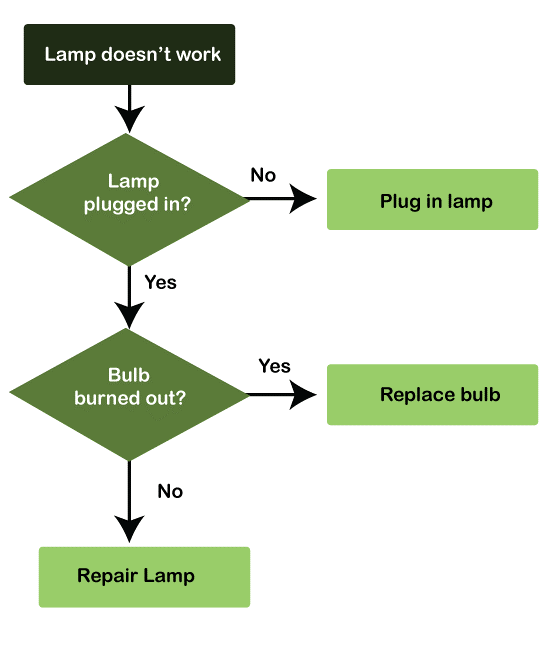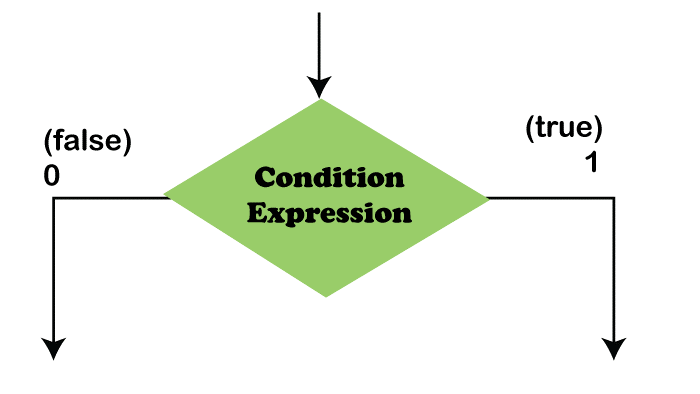What is a Decision Box?
A Decision Box, also known as a Decision Node or a Decision Point, is a term used in decision-making and process management. It is a graphical representation of a decision point in a process flowchart or a decision tree that indicates a branch in the decision-making process.

A Decision Box is a diamond shape in a flowchart, where the decision is made based on a condition or criterion. The diamond has two or more outgoing arrows, each representing a different possible outcome based on the decision made.
Decision Boxes are useful for visualizing decision-making processes, making them easier to understand and analyze. They are commonly used in business process modeling, software development, and project management to help teams identify decision points, potential outcomes, and areas for improvement.
If you want to check whether a lamp work or not. You might create a flowchart that looks like this:

In this example, the Decision Box represents the decision point where you decide whether lamp work or not.
Use of Decision Box in Flowchart
A Decision Box in a flowchart represents a point in a process where a decision must be made based on a condition or criterion. The Decision Box helps visualize the decision-making process and the possible outcomes of a particular decision.
Here are some of the common uses of Decision Boxes in the flowchart:
- Representing Yes/No decisions: Decision Boxes are commonly used to describe Yes/No decisions or binary decisions. For example, a Decision Box could mean choosing between two options, such as "Is the customer satisfied?" with Yes or No outcomes.

- Representing multi-option decisions: Decision Boxes can also define more complex decisions with multiple possible outcomes. For example, a Decision Box might mean a decision with three possible consequences, such as "What is the customer's preferred method of communication?" with phone, email, or chat outcomes.
- Providing clarity and organization: Decision Boxes help to make flowcharts more organized and easier to understand by clearly identifying decision points and the potential outcomes that can result from them.
- Analyzing decision-making processes: Flowcharts with Decision Boxes can be used to analyze decision-making processes and identify areas for improvement or optimization.
Decision Boxes are an important tool for visualizing decision-making processes and ensuring all possible outcomes are considered in a process flowchart.
Features of Decision Box
The Decision Box is a key element in decision-making and can be used as a flowchart tool to aid decision-making processes. Here are some of the key features of a Decision Box:
- Diamond shape: The Decision Box is represented by a diamond shape in a flowchart.
- Decision point: The Decision Box indicates a decision point where a choice must be made.
- Decision question: The Decision Box includes a question that needs to be answered or a decision to make.
- Alternatives: The Decision Box includes the different options that are being considered.
- Criteria: The Decision Box includes the criteria or factors used to evaluate each alternative.
- Pros and cons: The Decision Box includes the pros and cons of each alternative, which can be weighed against the criteria to make the best decision.
- Weights: The Decision Box includes the weights or priorities assigned to each criterion based on its importance.
- Final decision: The Decision Box includes the final determination that was made based on the evaluation of the criteria and alternatives.
The Decision Box is an important tool for decision-making, as it helps ensure that all options are considered and that the decision-making process is transparent and well-informed. It also allows individuals and teams to avoid common decision-making biases and ensures that the best possible decision is made at each step in the process.
Criteria Used for Making Decision Box
The criteria for making a decision box will depend on the specific decision and the context of the process being diagrammed. However, here are some common criteria that are often used when creating a decision box:
- Threshold criteria: This type of criteria is used when a specific threshold must be met before making a decision. For example, if a project budget exceeds a certain amount, a determination may be made about continuing.
- Risk vs. Reward: When deciding, weighing the potential risks and rewards associated with each possible outcome is often important. This can help ensure that the decision will maximize the benefits while minimizing the risks.
- Feasibility: A decision may need to be made based on whether a particular action is feasible. This could include factors such as time, resources, and expertise.
- Data and information: Decisions should be based on available relevant data and information. The decision box should include what data or information is needed to make the decision and who is responsible for providing it.
- Stakeholder input: It may be important to gather feedback from relevant stakeholders before deciding. The decision box should include who needs to be consulted and how their information will be collected.
- Legal and ethical considerations: Considering any legal or ethical implications is important. The decision box should include any relevant laws or moral principles that must be considered.
In general, the goal of a decision box is to help individuals or groups make informed decisions based on carefully considering available options and relevant factors.
Advantages of Decision Box
The Decision Box is a useful tool that can be used in flowcharts to aid in decision-making processes. Here are some of the advantages of using a Decision Box:
1) Considers multiple alternatives: The Decision Box helps individuals and teams assess various options when making decisions, which can lead to better outcomes.
2) Evaluates criteria objectively: It helps individuals and teams assess decision criteria objectively, which can help reduce decision-making biases.
3) Helps prioritize criteria: The Decision Box allows individuals and teams to prioritize decision criteria based on their importance, which can help ensure that the most critical factors are considered.
4) Increases transparency: The Decision Box helps increase transparency in the decision-making process, which can help build trust and collaboration among team members.
5) Facilitates communication: The Decision Box facilitates communication among team members, providing a clear and visual representation of the decision-making process.
6) Enables data-driven decisions: The Decision Box allows data-driven decisions, as it helps individuals and teams evaluate alternatives based on objective criteria.
7) Improves decision quality: The Decision Box helps enhance decision quality, ensuring that all relevant factors are considered.
The Decision Box is a valuable tool that can help individuals and teams make better decisions. By considering multiple alternatives, evaluating criteria objectively, and prioritizing decision criteria based on importance, the Decision Box can help improve decision-making processes and outcomes.